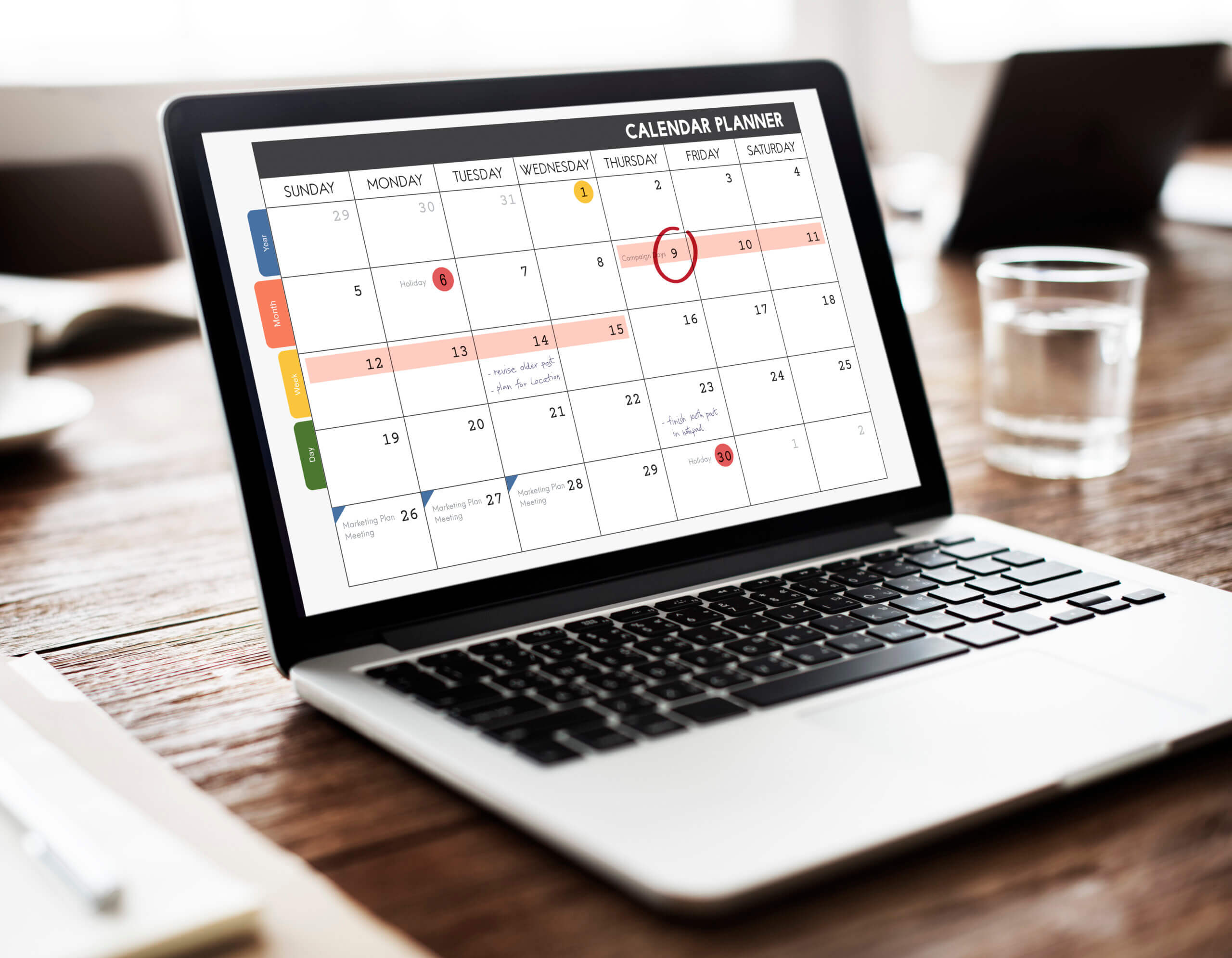The choice of the right marketing distribution channels directly affects your market penetration and sales level, customer outreach, and reputation.
What’s more, selecting the relevant distribution channel for your business is one of the key opportunities to boost sales, build strong partnerships, and enhance customers’ loyalty.
However, there is no one-size-fits-all strategy. Since each business and product is specific, you need to use specific marketing distribution channels as well.
In this article, I’m going to provide you with an in-depth overview and explanation of these points:
- What is the distribution channel?
- What are the main types of distribution channels?
- Real examples and use cases of different channels of distribution.
- How to choose the right marketing distribution channels for your business.
Let’s discover new insights!
What Is a Distribution Channel?
As for the distribution channel definition, this term can be explained quite simply. In a nutshell, this is the way your goods reach your buyers.
As a general rule, the channels of distribution may be divided into short and long ones. Logically, the shorter the distribution channel, the fewer intermediaries are between your end-users and you, and vice versa – a long distribution channel implies a chain of intermediaries.
Main Functions of Distribution Channels in Marketing
There are several essential functions distribution channels in marketing may perform:
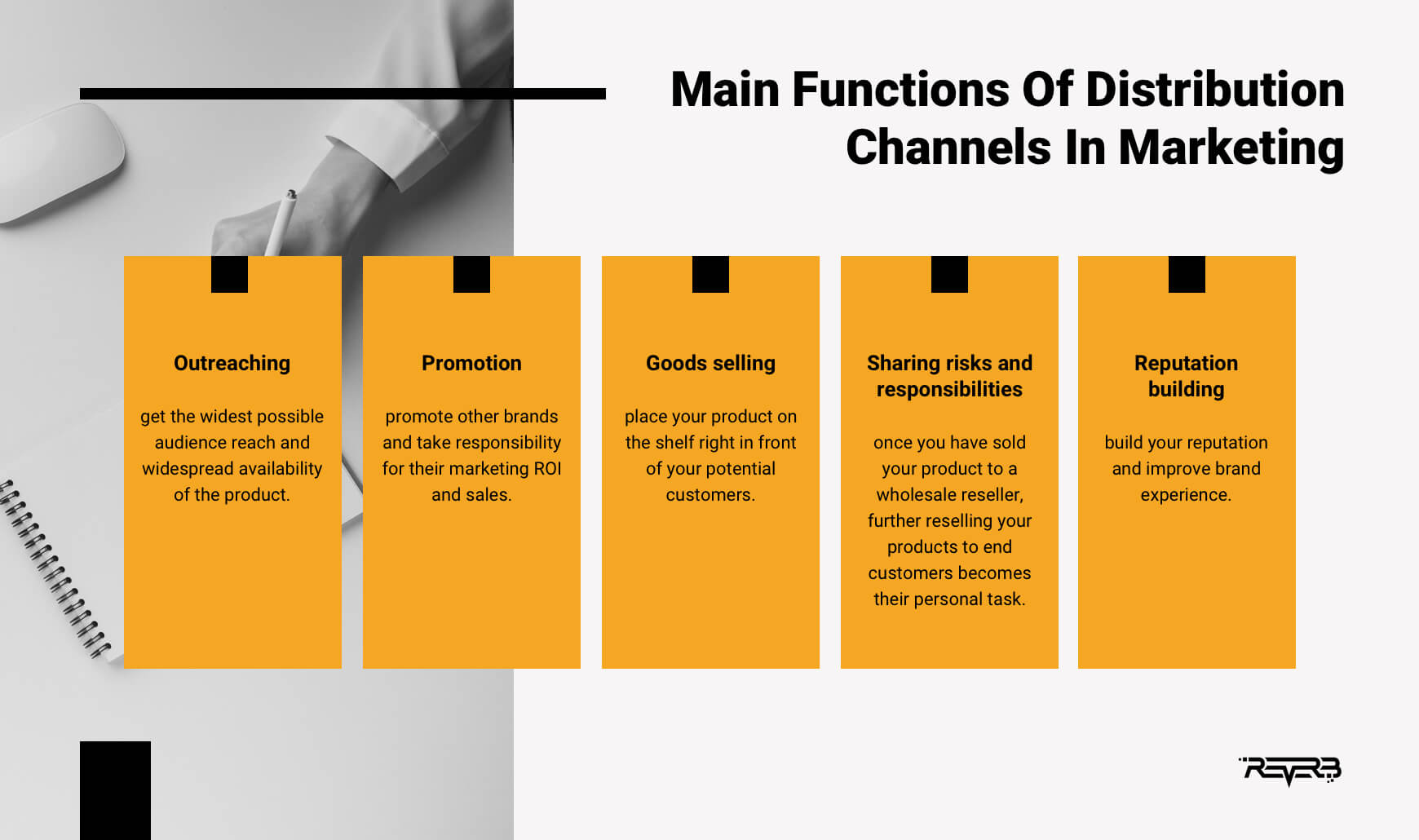
- Outreaching. Some distribution channels (for example, intensive distribution) aim to get the widest possible audience reach and widespread availability of the product. It comes in handy when it’s necessary to reach the largest possible number of potential buyers at different stages of the sales funnel.
- Promotion. There are also types of distribution channels you may use to partially absolve yourself of marketing responsibility. For example, a lot of retail resellers tend to promote other brands and take responsibility for their marketing ROI and sales.
- Goods selling. Using most distribution channels means that you, as a manufacturer, also get the opportunity to use the reseller’s sales space, which means placing your product on the shelf right in front of your potential customers.
- Sharing risks and responsibilities. Some of the types of distribution channels involve the purchase of your products for resale, which reduces your risks of not selling your product. Once you have sold your product to a wholesale reseller, further reselling your products to end customers becomes their personal task.
- Reputation building. The marketing distribution channels you use also help build your reputation. This is especially true for exclusive and selective distribution (I will explain these terms later), where brand experience and reputation are as important to the buyer as the quality of your product and the luxury of having it.
6 Main Types of Distribution Channels
So, let’s discover some of the main marketing distribution channels, and then find out which one is the best fit for your business.
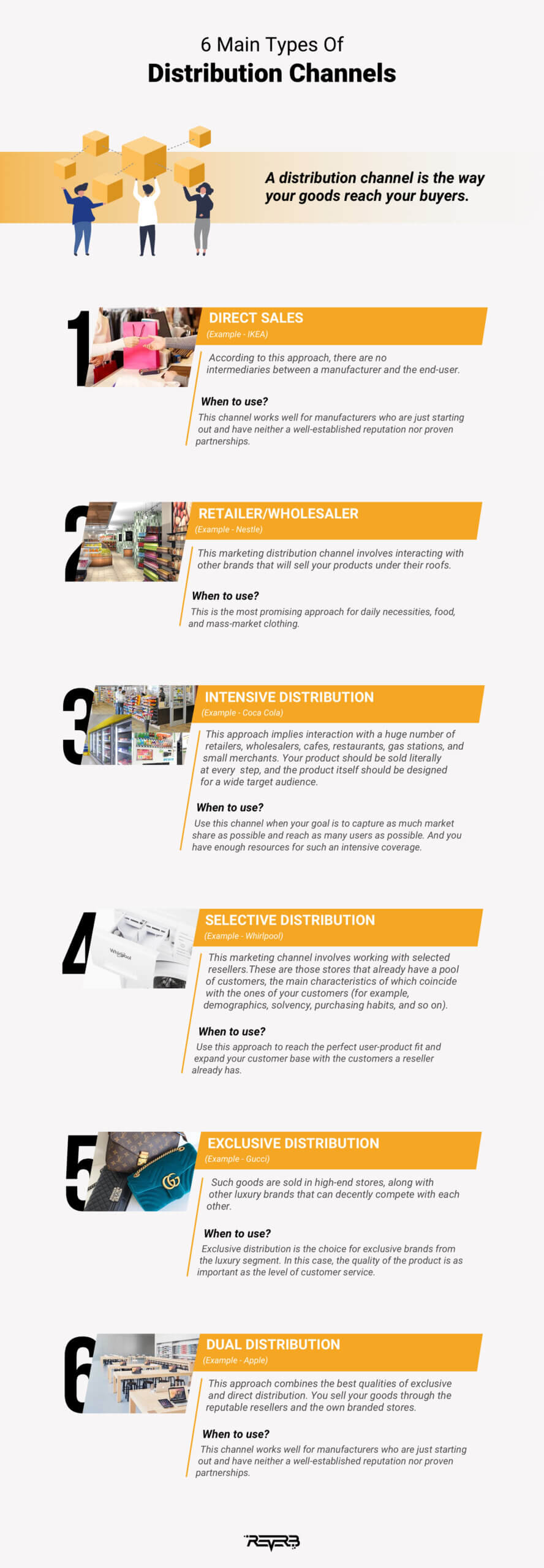
1. Direct sales
✓ Distribution channel example – IKEA
According to this approach, there are no intermediaries between a manufacturer and the end-user. What’s more, the direct distribution channel (or D2C – direct-to-customer) is expected to be on the rise in 2021 and take its place among the main eCommerce trends of the upcoming year.
This сhannel works well for manufacturers who are just starting out and have neither a well-established reputation nor proven partnerships. In this case, manufacturers begin to build relationships with customers directly using digital and social media marketing.
However, this does not mean that direct selling is only suitable for startups. Ikea has been using this approach for nearly 80 years.
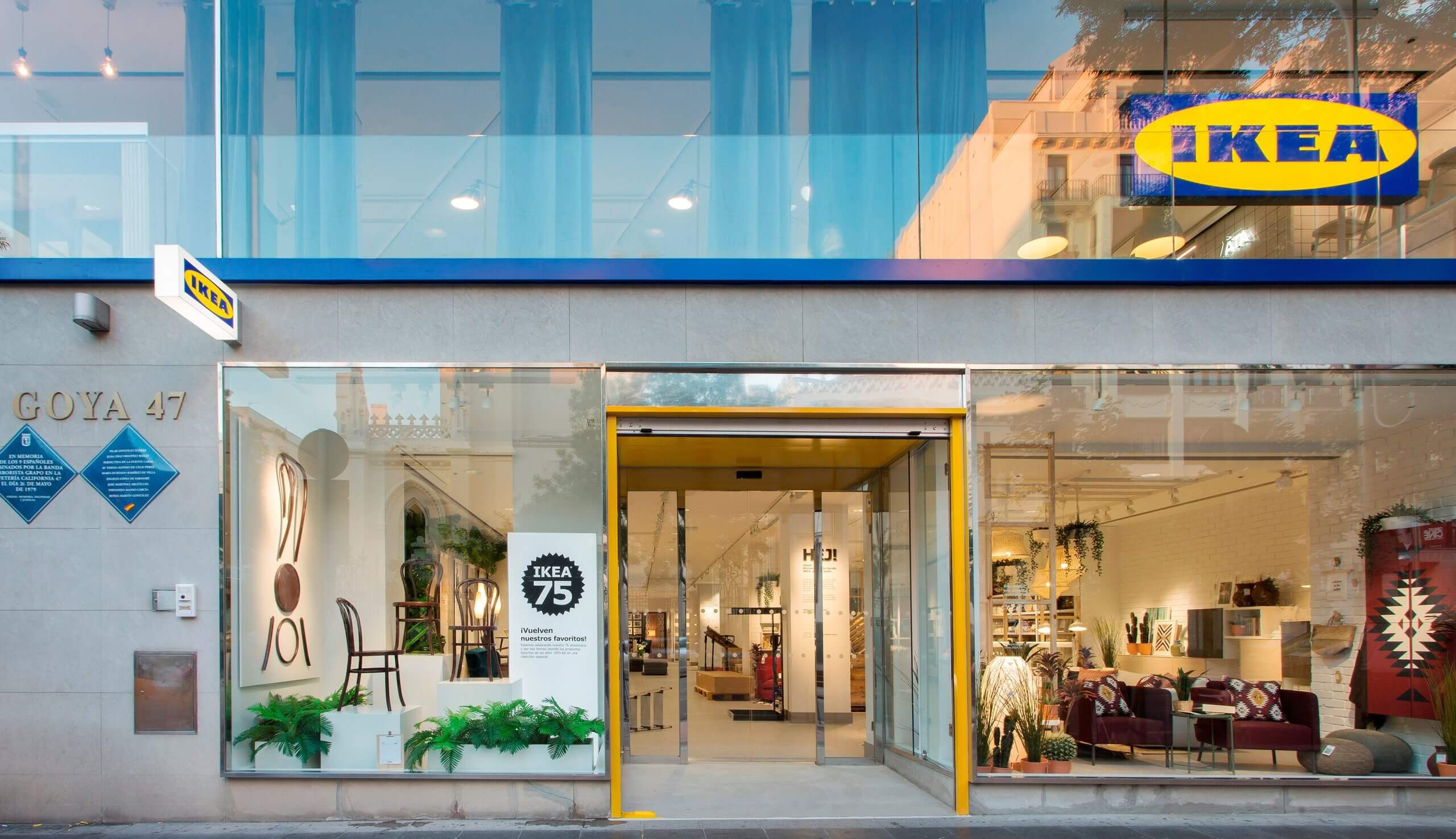
2. Retailer/Wholesaler
✓ Distribution channel example – Nestle
This marketing distribution channel involves interacting with other brands that will sell your products under their roofs. The main advantage of working with retailers and wholesalers is that they buy your products in large quantities and then take responsibility for the further sales process.
This is the most promising approach for daily necessities, food, and mass-market clothing. However, this channel has the greatest potential when your brand has already become quite recognizable, and retailers do not risk losing profits by buying your product for further resale.
An example of this approach is Nestlé. You can find products of this brand in almost all chain supermarkets and small stores.

3. Intensive distribution
✓ Distribution channel example – Coca Cola
The essence of this approach is to capture as much market share as possible and reach as many users as possible.
However, there is an important note. Such a distribution channel implies interaction with a huge number of retailers, wholesalers, cafes, restaurants, gas stations, and small merchants. In other words, your product should be sold literally at every step, and the product itself should be designed for a wide target audience.
Coca Cola is a perfect example of a brand for which this strategy has been working for many years. This drink is sold in any grocery store, cafe or restaurant, and is loved by both adults and children all over the world.

4. Selective distribution
✓ Distribution channel example – Whirlpool
This marketing channel involves working with selected resellers. As a rule, these are those stores that already have a pool of customers, the main characteristics of which coincide with the ones of your customers (for example, demographics, solvency, purchasing habits, and so on).
This channel is quite effective when you want to reach the perfect user-product fit and expand your customer base with the customers a reseller already has.
For example, Whirlpool brand products are only sold in selected electronics and appliance stores.

5. Exclusive distribution
✓ Distribution channel example – Gucci
Exclusive distribution is the choice for exclusive brands from the luxury segment. In this case, the quality of the product is as important as the level of customer service.
Therefore, luxury brands choose truly exclusive resellers capable of delivering exceptional buyer experience.
For example, you can hardly find a Rolex watch or Gucci in a typical mall with an average price level. These goods are sold in high-end branded stores and marketplaces along with other luxury brands that can decently compete with each other.

6. Dual distribution
✓ Distribution channel example – Apple
This approach combines the best qualities of exclusive and direct distribution, that is, the manufacturer prefers to sell its goods through selected resellers who are well recognized and have an unblemished reputation in the market.
Plus, the manufacturer maintains its own branded stores where users can get the best experience from interacting with the brand directly.
For example, Apple effectively uses this distribution channel strategy. The company simultaneously has branded stores in 25 countries and also distributes its devices through selected resellers in countries where official stores have not yet opened or are not planned to.

How to Decide on the Right Channels of Distribution for Your Business
We’ve overviewed the specifics of each distribution channel in marketing, so it’s time to make the right choice for your unique business case.
Just follow this easy flow:
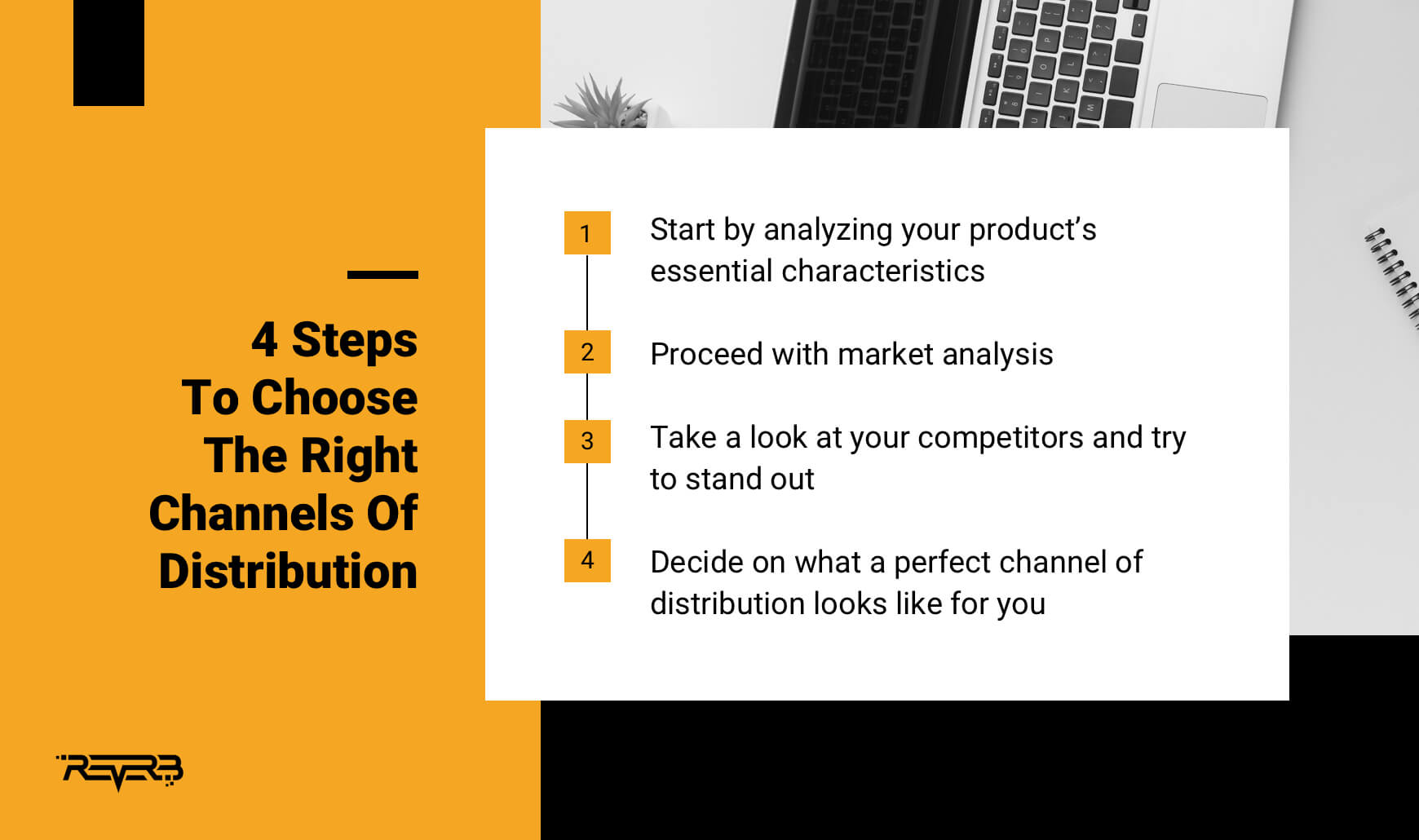
Step 1 – Start by analyzing your product’s essential characteristics
The first thing to do is to take a fresh look at your product. Its specifics will tell you which distribution strategy makes the most sense.
For example,
- If you are producing perishable food, it makes sense to negotiate supplies with retailers and wholesalers to get the product to the shelf and to the user’s basket as quickly as possible.
- If you are developing a luxury brand, your products must be sold exclusively.
- If you want to have complete control over your distribution chain, then direct selling is the best option. Plus, you will always be on the same page with your customers.
Step 2 – Proceed with market analysis
There is nothing more useful than market analysis when deciding on distribution channels. The analysis and its results will show you the right path and save you from mistakes.
For example, it makes no sense to choose an intensive distribution strategy if the market is already filled with a similar product.
Plus, competing with global brands isn’t the smartest idea either. In this case, you need to find a free niche that suits your product and choose the appropriate marketing channel.
Step 3 – Take a look at your competitors and try to stand out
Missing your competitors’ analysis would also be wrong, as well as copying their distribution strategy. After analyzing your competitors’ approaches, you need to find weaknesses in their distribution channels.
For example, you can benefit from a direct selling strategy that allows you to firstly offer a better price, and secondly, to speed up the delivery of goods to the end consumer and offer a more personalized experience.
Step 4 – Decide on what a perfect channel of distribution looks like for you
Most likely, at this stage, you already understand which distribution channel is best for you.
However, let’s imagine your ideal option. What will it look like?
Find the answers to the following questions to get a holistic picture:
- Where do your users potentially want to buy your product?
- What should be the ideal user impression made by your product?
- What kind of experience should they get from interacting with your brand?
- Does working with intermediaries really make sense for you?
- Are you ready to invest time in developing relationships with resellers and wholesalers?
- Do you have enough resources to expand and control the supply chain?
Answering these questions will help you clearly understand what is right for promoting your product, and which distribution channel will be the most effective considering the resources that your company already has.
Conclusion
So, we have figured out what distribution channels are and how to choose the right one for your business.
However, the competent outside perspective will still be effective to make the most of your choice. Our strong marketing team may assist you by providing our practice-proven advice and hands-on promotion experience.
Feel free to reach out to us and continue the conversation regarding your business development strategy and marketing channels that will be effective in your specific case.














